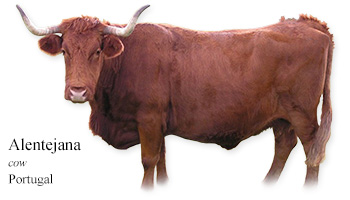



Alentejana
(most common name)
(local/other name):
• Raça Bovina Alentejana
(historical breed name):
• Transtagana
The Alentejana was, for centuries where it originated, the most important working breed on the plains and in the hills of Alentejo — a south-central region of Portugal. Across the border, Spain has essentially this same breed which is known as the Retinta.
The Alentejana’s original morphology was determined by an unbalanced diet and working for long periods in a hot, dry climate. However, starting in the mid-1900s, mechanization of farm labor slowly took over and selection for beef became primary. Thus, their production management was modified to achieve a better shape and carcass and cutting yields. When this wasn’t satisfactory, breeders tried increased, and sometimes indiscriminate, crossbreeding with imported exotic breeds (including the Salers and Charolais). Eventually these practices led to purebred Alentejana numbers declining.
In reaction to this, the Alentejana herdbook was finally established by 1970. Over time, spurred by greater demand from consumers, breeders of all the native Portuguese breeds started working to curb the genetic regression occurring in their herds. National and community programs which promoted conservation and the sustainable use of animal genetic resources were implemented and producers began marketing their beef as Protected Designation of Origin (PDO) products.
By 2003, 47% of all PDO beef in Portugal was from the Alentejana. However, the recovery of breed purity has created the problem of reduced genetic diversity which breeders today are now addressing.
(Portuguese) Alentejana = south of Tagus
Iberian Red cattle (central and south) are described as:
• medium to big in size
• a broad head with a somewhat convex (spherical) profile
• long, widespread horns with upturned points
• a long body with a deep chest
• a well-developed dewlap
• a sloping rump
• rather short legs
• coat color is red - from blonde to mahogany brown, unicolored or pied
This breed is included in the following groups:
• E GROUP: Europe (Southwest)
• E-5: Iberian (Central, South)/Red
• R: Andaluza Rojo convexo
• R: Iberian Red
This page was last updated on: 2023-05-13
Laguage: Portuguese
Pronounced:
ah-lehn-teh-ZSHAH-nah
Location within Portugal:
Alentejo, southern Portugal
Use: Provision
Dam line
General crossbreeding
Herding
Horns
Meat
Use: Regulation And Maintenance
Fire protection
Habitat provision and biodiversity
Vegetation management
Use: Cultural
Research
Color:
unicolor (yellow to golden red, mahogany brown)
Morphology INFO as of 1995 :
Average height at withers (male):
155 cm / 61 inches
Average height at withers (female):
140 cm / 55 inches
Average weight (male):
1,000 kg / 2,205 lbs
Average weight (female):
700 kg / 1,543 lbs
Horns:
males: 2
females: 2
description: long, widespread and usually upturned points
General Performance:
Average parturition interval (days): 430
Average age at first parturition (months): 31
Average birth weight (male):
32 kg / 70.5 lbs
Average birth weight (female):
30 kg / 66 lbs
Years of productive life: 10
Milk Performance:
Average number of lactations: 10
Population Data as of 2022:
Population: 21,043
Trend: stable
Breeding males: 198
Breeding females: 20,845
Females registered in herdbooks: 14,261
Females bred pure: 60
Number of herds: 136
Average herd size: 155
Artificial Insemination (AI) used: yes
Artificial Insemination (AI) males used: 16
In situ conservation programs: yes
Cryo Programs: yes


You can also go to:
My Daily Cow® Portugal and read about other Portuguese cattle breeds.
The Cow Wall® A-Z Cattle Breed Picture Reference to see other breeds of cattle in the world.